
At Bula Kava House, patrons of our Portland kava bar know that we believe moderation is important when enjoying a coconut shell of your favorite kava root or when having a drink out. The idea of moderation becomes especially important with New Year's Eve right around the corner. However, due to the rising alcohol levels in beer and wine, the drinks served in restaurants and bars may contain more alcohol than many patrons realize, according to the results of a new study.
As a result of these increased alcohol content, many conscientious drinkers who adhere to a one or two-drink limit when out in public could easily find themselves over the legal limit for operating a motor vehicle or accidentally drink more alcohol than recommended for maintaining quality health.
The results of this study were conducted and released online by the National Alcohol Beverage Control Association.
A Fine Line
Currently, the U.S. Department of Agriculture recommends that individuals who consume alcohol do so in moderation; meaning that women enjoy no more than one drink a day and that men don’t enjoy more than two beverages a day.
The USDA’s guidelines define one “drink” as 12 ounces of beer that contains five percent alcohol, five ounces of wine with a 12 percent alcohol content, and 1.5 ounces of 80 proof alcohol, which average 40 percent alcohol by volume. If producers continue to ratchet up the alcohol content of beverages, the USDA may need to shrink the sizes of what constitutes a drink to offset this difference. However according to researchers at the Public Health Institute’s Alcohol Research Group, the likelihood of the USAD reducing what constitutes a drink isn’t great.
The problem with reducing what the USDA classifies as a drink is the lack of uniformity in alcohol content by spirit producers. For example, while Budweiser, Miller, and Coors might consistently produce beer with a five percent alcohol content, the rise of micro-breweries that produce beers that can range upwards of 10 or 11 percent in alcohol content make the USDA’s recommended servings useless. Even wine makers routine produce vintages that have an alcohol content of 14 to 15 percent.
That most bars and restaurants serve beers in pints (16 oz) and glasses of wine that routinely measure six or seven ounces only further complicates establishing a concrete guideline.
If an unsuspecting bar patron orders a pint of beer that measures 10 percent alcohol content, he could easily consume nearly 2.5 times more alcohol in one drink than expected. Under this scenario, it wouldn’t take more than a few beverages in a short period of time to quickly put the patron over the legal limit for driving.
Better Guidance Required
When viewed together, these examples suggest that Americans need better guidance when it comes to healthy drinking, says researchers from the Rutgers Center for Alcohol Studies in response to this study.
So what can you do to moderate your drinking when out in public?
In most situations, carefully reading the label of whatever your drinking and determining the measurement of each serving can help ensure you don’t become over served. When at home, you should always know how much your drinking and what the alcohol content of the beverage. While you don’t need to measure your pours every time you refill your glass, it might not be a bad idea to measure out your first glass so you know what a standard pour looks like.
When out at a bar or restaurant, a good rule-of-thumb is to assume that poured cocktails and glasses of wine are closer to one-and-a-half times the size of a standard drink. Regardless of the size of each beverage, keep in mind that the body can only successfully process one beverage an hour. However, women and certain ethnic groups, such as Native Americans and Asians, may process alcohol more quickly, leading to faster intoxication.
Remember, once you’ve hit your max, switch to water or another non-alcoholic beverage so you can maintain control. Studies have shown that frequent uncontrolled binge drinking can lead to a variety of health problems, such as liver failure, cancer, and poor oral health, which by itself can increase your risk of heart disease, stroke, and diabetes. So from all of us here at our Portland kava bar, remember that when you drink, make sure to drink responsibly.
